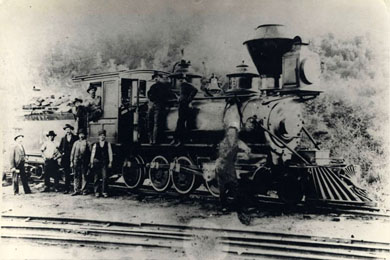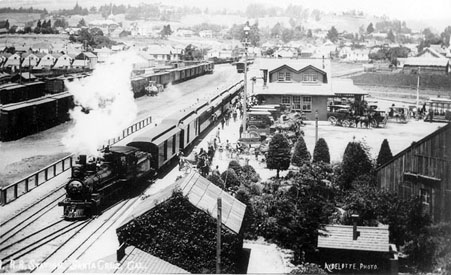South Pacific Coast Railroad
 The South Pacific Coast Railroad was a three foot narrow gauge short line railroad, connecting the San Francisco Bay area with San Jose and Santa Cruz. The busy railroad carried commuters and travelers from small farm towns and logging camps to the cities, transported lumber from the Santa Cruz Mountains and transported produce from the Santa Clara Valley.
The South Pacific Coast Railroad was a three foot narrow gauge short line railroad, connecting the San Francisco Bay area with San Jose and Santa Cruz. The busy railroad carried commuters and travelers from small farm towns and logging camps to the cities, transported lumber from the Santa Cruz Mountains and transported produce from the Santa Clara Valley.
Financed primarily by James Fair, of Nevada's Comstock mining fame, the SPC began construction of its line, between Dumbarton Point and Newark, in 1876. Initially the line connected with San Francisco via a ferry from Dumbarton Point. Construction of the line reached San Jose by the end of 1877.
On March 20, 1878, the line between Park Street, in Alameda, and Los Gatos was opened. On June 1, 1878 the line to the ferry slip in Alameda was completed. The SPC opperated two ferries between Alameda and San Francisco which offered hourly trips beginning in July 1878. Santa Cruz was reached on May 15, 1880, 75.3 miles from the Alameda ferry Slip. A trip from San Francisco to Santa Cruz took three hours and 55 minutes including the ferry ride across the bay to Alameda.
A station at 12th and Webster Streets in Oakland was reached via a municipal bridge on May 30, 1881, an extension to 14th and Franklin opened on October 1, 1886. Passengers on the SPC beat the Southern Pacific commute time from San Francisco to Oakland by eight minutes. The "Alameda Mole" ferry terminal opened March 15, 1884.
The line had five branches, three of them were powered by horses. The three mile long Centerville Branch, located about a mile south of Ardenwood, used horses as its only motive power from 1881 to 1909.
 The Southern Pacific leased the SPC from Fair, beginning on July 1, 1887. The line operated 95 miles of track. By the late 1880's, a total of 33 passenger trains ran each direction daily. An 1892 roster indicates that the railway owned 22 locomotives, 79 passenger cars, 605 freight cars, 7 cabooses and three ferryboats. Many of the cars were built by Carter Brothers in Newark, California.
The Southern Pacific leased the SPC from Fair, beginning on July 1, 1887. The line operated 95 miles of track. By the late 1880's, a total of 33 passenger trains ran each direction daily. An 1892 roster indicates that the railway owned 22 locomotives, 79 passenger cars, 605 freight cars, 7 cabooses and three ferryboats. Many of the cars were built by Carter Brothers in Newark, California.
The Southern Pacific dual gauged the line through Alameda to provide standard gauge local service in 1902. Standard gauging of the main line was planned for April 18, 1906, but was delayed by the San Francisco earthquake. Standard gauge service was completed between Oakland and San Jose during 1906, but narrow gauge service continued at the south end until January 1908 as the narrow gauge cars and locomotives were more practical to use to repair the earthquake damage in the Santa Cruz Mountains.
The line through Alameda, along Encinal Avenue, was electrified in 1911 as part of the Southern Pacific's suburban electrification of the East Bay, becoming part of the SP's Interurban Electric Railway in 1934. A decline in patronage led to abandonment of the line in 1941. The line through Oakland became a streetcar line, lasting through 1923.
In the south, the SP's Sun Tan Specials to Santa Cruz were popular until the use of automobiles replaced them. Passenger service ended on March 4, 1940, and the scenic mountain line from Los Gatos to Olympia was abandon.
Today the Santa Cruz Big Trees & Pacific Railway, operating from Felton to Santa Cruz, provides tourist service along the scenic south end of the line. The northern portion of the SPC continues to be operated as part of the Union Pacific Railroad.
South Pacific Coast Railroad Coach No. 39
The last known existing example of a full length coach built by Carter Brothers in Newark, California during the companies early years, this coach was built for the South Pacific Coast as Coach No. 39 in 1881. It is built of wood and is 39 ft. 11 in long (over end sills). It was used in commuter service between Alameda and Oakland. The South Pacific Coast also operated extensive passenger service from Oakland, through San Jose, to Santa Cruz.
Carter Brothers was a California firm that built a variety of passenger and freight cars and contracted the construction of several California short line railroads, primarily narrow gauge.
In 1903 Coach No. 39 was in use in commuter service between Alameda and Oakland. SP records described the car as including "combined side and cross rattan seats with a stove." It was painted SP coach green.
Southern Pacific Records indicate that Coach No. 39 was taken off the passenger car roster in December 1909, following the 1906-07 standard gauging of the line. It is not know why it was one of several cars kept on the roster for nearly two years after the standard gauging of the line was completed. It is not known when the car was relettered Southern Pacific.
By the mid-1930's, Coach 39's body was in use as section housing near the corner of Mission and 11th Streets in San Miguel, CA. It was assigned to Victor S. Martinez, a Southern Pacific track work and his wife Maria. Partitions were added inside the car dividing it into a dining room, living room and bedroom. Seven Martinez children were born in the bedroom. After Mr. Martinez retired in 1957, he acquired the car body from the SP wanting to see it preserved.
The classic "duck bill" style roof, walls and floor of the car are structurally sound, and with the exception of one end, have not been modified since the car was in train service. An original door remains at one end of the car. Most of the original oak window sash and varnished interior woodwork inside the care remain intact, revealing the fine craftsmanship of the nineteenth century car builders.
The car body was donated to Orange Empire Railway Museum in 1993 by the Martinez family in memory of of Victor and Maria Martinez.
Other equipment from the SPC is preserved by the Society for the Preservation of Carter Railroad Resources, which operates the Railroad Museum at Ardenwood Historic Farm Regional Park in Fremont, California.
Sharing A Heritage Railroad History Train Technology Railroad Operation Railroad Time Museums & Heritage Railroads Railroads Today
